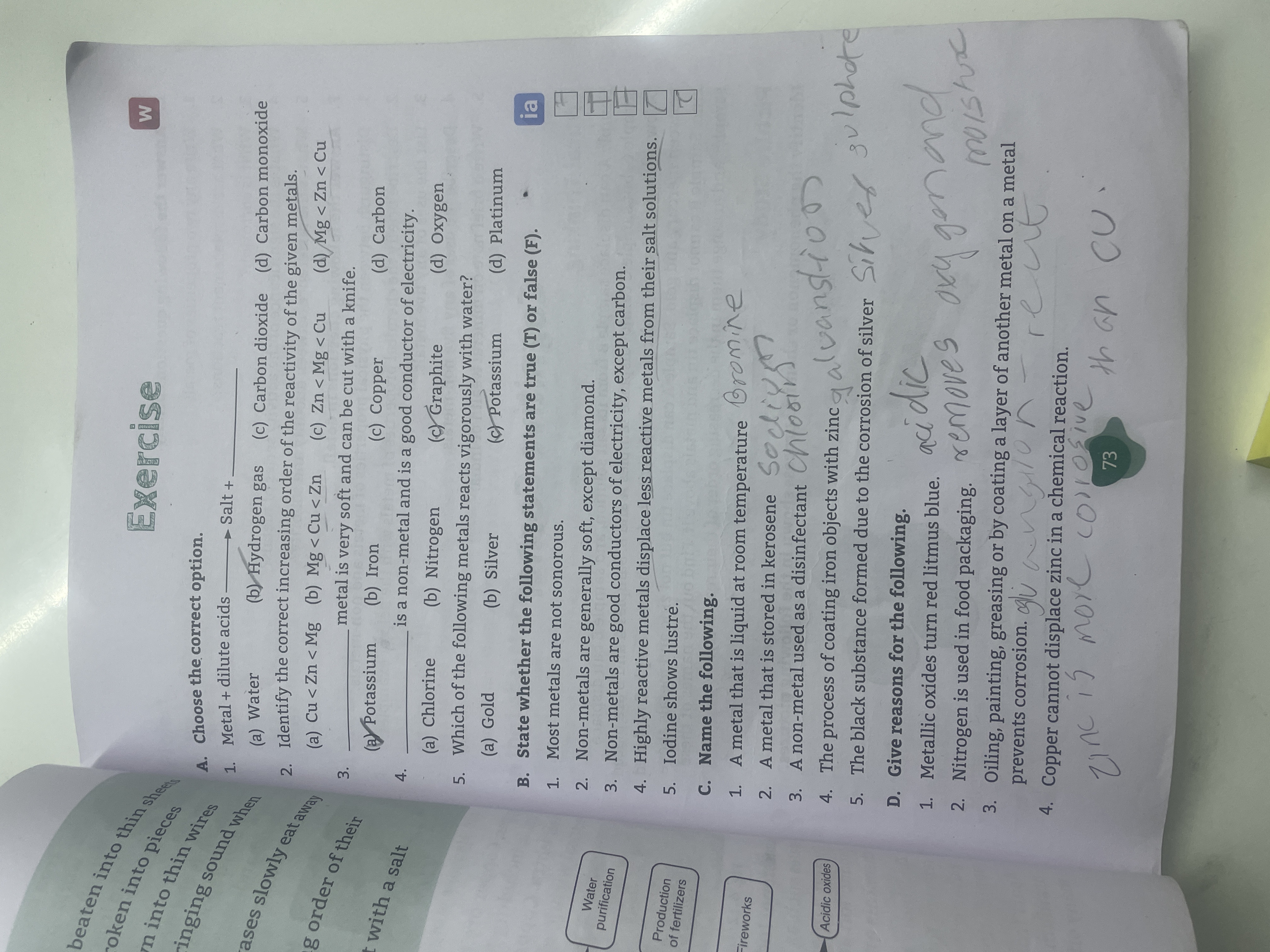A. Choose the correct option. 1. Metal + dilute acids → Salt + ? 2. Identify the correct increasing order of the reactivity of the given metals. 3. ______ metal is very soft and ca... A. Choose the correct option. 1. Metal + dilute acids → Salt + ? 2. Identify the correct increasing order of the reactivity of the given metals. 3. ______ metal is very soft and can be cut with a knife. 4. ______ is a non-metal and is a good conductor of electricity. 5. Which of the following metals reacts vigorously with water? B. State whether the following statements are true (T) or false (F). 1. Most metals are not sonorous. 2. Non-metals are generally soft, except diamond. 3. Non-metals are good conductors of electricity, except carbon. 4. Highly reactive metals displace less reactive metals from their salt solutions. 5. Iodine shows lustre. C. Name the following. 1. A metal that is liquid at room temperature. 2. A metal that is stored in kerosene. 3. A non-metal used as a disinfectant. 4. The process of coating iron objects with zinc. 5. The black substance formed due to the corrosion of silver. D. Give reasons for the following. 1. Metallic oxides turn red litmus blue. 2. Nitrogen is used in food packaging. 3. Oiling, painting, greasing or by coating a layer of another metal on a metal prevents corrosion. 4. Copper cannot displace zinc in a chemical reaction.

Understand the Problem
The image contains a series of chemistry questions related to metals, non-metals, their properties, reactions, and uses. The questions range from multiple-choice, true/false statements, fill in the blanks, and reasoning questions.
Answer
Here are the answers: A. 1. (b), 2. (a), 3. (a), 4. (c), 5. (c) B. 1. F, 2. T, 3. F, 4. T, 5. T C. 1. Mercury, 2. Sodium, 3. Chlorine, 4. Galvanization, 5. Silver sulfide D. See answer for reasons.
A.
- (b) Hydrogen gas
- (a) Cu < Zn < Mg
- (a) Potassium
- (c) Graphite
- (c) Potassium
B.
- False
- True
- False
- True
- True
C.
- Mercury
- Sodium
- Chlorine
- Galvanization
- Silver sulfide
D.
- Metallic oxides are basic, turning red litmus blue.
- Nitrogen is unreactive and prevents oxidation and spoilage.
- These methods prevent contact with air and moisture.
- Copper is less reactive than zinc, so it cannot displace it.
Answer for screen readers
A.
- (b) Hydrogen gas
- (a) Cu < Zn < Mg
- (a) Potassium
- (c) Graphite
- (c) Potassium
B.
- False
- True
- False
- True
- True
C.
- Mercury
- Sodium
- Chlorine
- Galvanization
- Silver sulfide
D.
- Metallic oxides are basic, turning red litmus blue.
- Nitrogen is unreactive and prevents oxidation and spoilage.
- These methods prevent contact with air and moisture.
- Copper is less reactive than zinc, so it cannot displace it.
More Information
Here is additional information on the answers. A.1. When a metal reacts with a dilute acid, it produces a salt and hydrogen gas. A.2. The reactivity series dictates the order of reactivity, with copper being less reactive than zinc and magnesium. A.3. Potassium is an alkali metal that is soft enough to be cut with a knife. A.4. Graphite, an allotrope of carbon, is a non-metal that is a good conductor of electricity. A.5. Potassium reacts vigorously with water, producing hydrogen gas and heat. C.1. Mercury is a metal that is liquid at room temperature. C.5 The black substance formed due to the corrosion of silver is silver sulfide.
Tips
A common mistake is confusing the order of metal reactivity. Also, remember that metallic oxides are basic, not acidic.
Sources
AI-generated content may contain errors. Please verify critical information